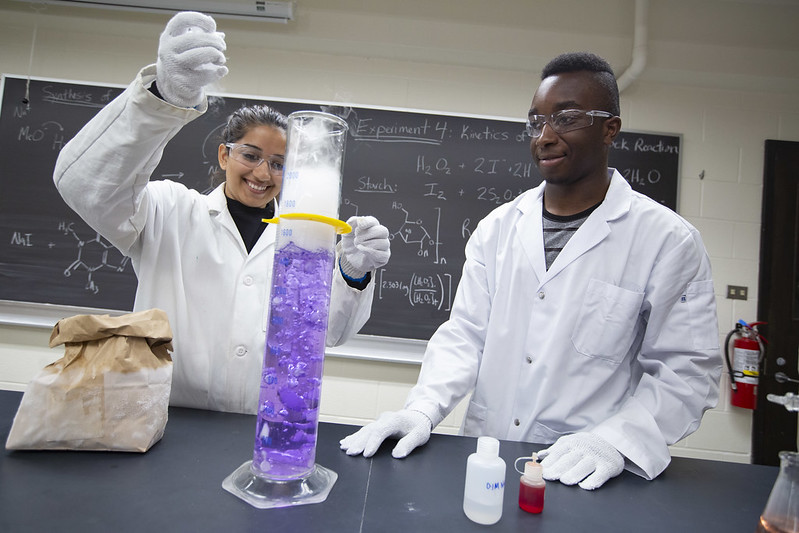-
Challenging Conversations – The Stories We Tell
This is the first in a short series on having challenging conversations either in your classes or individually with students. The topics covered in these posts come from the GMCTL short-course Challenging Conversations. The ideas and concepts shared in the course and these posts were contributed in large part by Dr. Rose Roberts, Roberta Campbell-Chudoba, Dr. Wendy James, and myself, Heather Ross. One of the first concepts we talk about in the Challenging Conversations short-course is the stories we tell. While later in the course we talk about the importance of storytelling in many cultures and the role it can play in your own courses, this initial discussion is about…
-
SDG 5 Gender Equality – Embedding the Sustainable Development Goals in Learning
This blog post is part of a series around the 17 Sustainable Development Goals (SDGs). Each post will dive into one of the goals and how we as educators can strive to embed these into our own courses. It is in the author’s opinion that any course or class can connect with one of the 17 goals or 169 sub-targets. By providing this blog post series, we hope to elicit some ideas of how you might also integrate a global goal into your teaching. Please refer to the USask SDG Teaching & Learning Workbook, review the USask Sustainability in the Curricula website, or scroll down for more information about the…
-
SDG 4 Quality Education – Embedding the Sustainable Development Goals in Learning
This blog post is part of a series around the 17 Sustainable Development Goals (SDGs). Each post will dive into one of the goals and how we as educators can strive to embed these into our own courses. It is in the author’s opinion that any course or class can connect with one of the 17 goals or 169 sub-targets. By providing this blog post series, we hope to elicit some ideas of how you might also integrate a global goal into your teaching. Please refer to the USask SDG Teaching & Learning Workbook, review the USask Sustainability in the Curricula website, or scroll down for more information about the…
-
SDG 3 Good Health and Well-Being – Embedding the Sustainable Development Goals in Learning
This blog post is part of a series around the 17 Sustainable Development Goals (SDGs). Each post will dive into one of the goals and how we as educators can strive to embed these into our own courses. It is in the author’s opinion that any course or class can connect with one of the 17 goals or 169 sub-targets. By providing this blog post series, we hope to elicit some ideas of how you might also integrate a global goal into your teaching. Please refer to the USask SDG Teaching & Learning Workbook, review the USask Sustainability in the Curricula website, or scroll down for more information about the…
-
SDG 2 Zero Hunger – Embedding the Sustainable Development Goals in Learning
This blog post is part of a series around the 17 Sustainable Development Goals (SDGs). Each post will dive into one of the goals and how we as educators can strive to embed these into our own courses. It is in the author’s opinion that any course or class can connect with one of the 17 goals or 169 sub-targets. By providing this blog post series, we hope to elicit some ideas of how you might also integrate a global goal into your teaching. Please refer to the USask SDG Teaching & Learning Workbook, review the USask Sustainability in the Curricula website, or scroll down for more information about the…
-
Introduction to Teaching Online
If someone asked you “How is online teaching different from face-to-face teaching?”, the first thing you might say is that face-to-face teaching involves real time interaction between students and instructors (synchronous) whereas online teaching happens through a computer, with students typically working through course content like lectures and other materials in their own time (asynchronous). In an online environment students and instructors access the course at different times and from different places; therefore, it is necessary to deliberately build in opportunities to develop a rapport with students and guide them through the course so that they are successful. There are a number of strategies that are effective in online courses that…
-
Using Your Syllabus to Set the Tone for Class
The syllabus is often the first window that students get into a course. An instructor may post it to Canvas, email it, or even still hand out printed copies. While the university sees it as a contract, and instructors and students see it as a description of expectations for course work, the syllabus can do a lot to set the tone for a class. Syllabi are often long, and honestly, dry. Is it any wonder that many students never read them, preferring to ask the instructor or peers questions when they already have the answers at their fingertips? While there are activities that can be done to encourage students to read the syllabus (scavenger hunts for…
